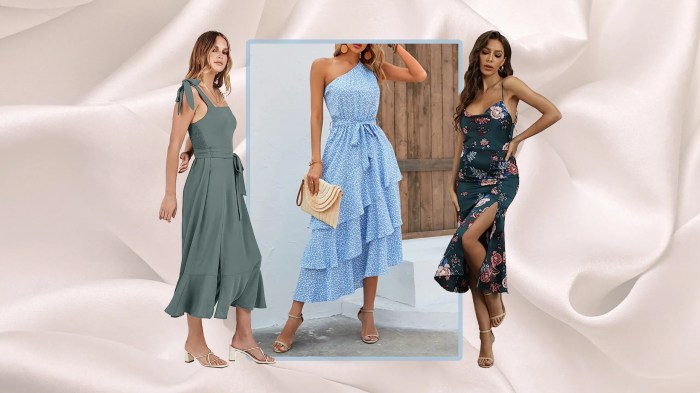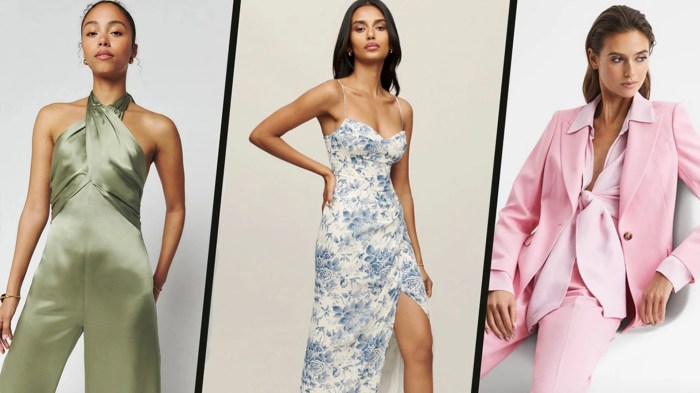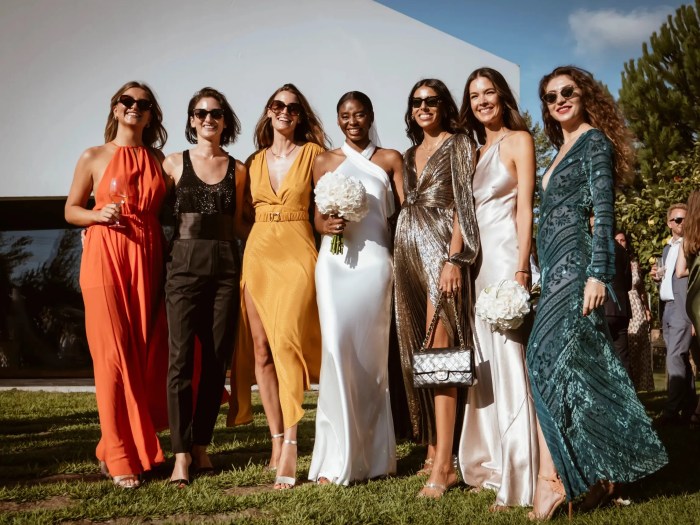Wedding Guest Dress Etiquette and Inspiration
Wedding dress guest dress – Navigating the world of wedding guest attire can feel overwhelming. From deciphering dress codes to choosing the perfect accessories, understanding the nuances of appropriate guest dressing ensures you celebrate the happy couple without overshadowing the bride. This guide offers insights into wedding guest etiquette, drawing inspiration from wedding dress styles to help you make informed choices.
Appropriate Attire for Various Wedding Styles
The wedding’s formality significantly influences appropriate attire. Formal weddings, often held in grand venues like ballrooms or churches, call for elegant floor-length gowns or sophisticated cocktail dresses. Semi-formal weddings allow for more flexibility, with midi dresses, stylish jumpsuits, or elegant pantsuits being suitable choices. Casual weddings, frequently held outdoors or in less formal settings, may permit more relaxed attire, such as knee-length dresses, skirts and tops, or even stylish jumpsuits.
The venue itself plays a crucial role in determining appropriate attire; a beach wedding might necessitate a lighter, more breathable outfit compared to a formal church wedding.
Wedding Venue’s Impact on Dress Choices
The wedding venue significantly impacts the appropriate attire. A rustic barn wedding might call for a flowy maxi dress or a stylish jumpsuit, while a formal cathedral wedding would necessitate a more elegant floor-length gown or a sophisticated cocktail dress. Beach weddings often suggest lighter fabrics and shorter hemlines, whereas a city hall wedding might allow for a more contemporary and less formal outfit.
Examples of Acceptable and Unacceptable Guest Attire, Wedding dress guest dress
Understanding acceptable and unacceptable attire is crucial. For a formal wedding, a floor-length gown in a rich fabric is appropriate, while jeans and a t-shirt are not. For a casual wedding, a sundress or a chic jumpsuit works well, but a white dress or anything too revealing should be avoided. Always consider the wedding’s theme; a bohemian wedding might suggest flowing fabrics and earthy tones, while a classic wedding might call for more traditional styles.
Appropriate Dress Codes for Various Wedding Settings
| Wedding Setting | Dress Code | Acceptable Attire | Unacceptable Attire |
|---|---|---|---|
| Formal (Ballroom, Cathedral) | Black-Tie Optional/Formal | Floor-length gowns, elegant cocktail dresses, tuxedos, suits | Jeans, casual dresses, sneakers |
| Semi-Formal (Restaurant, Garden) | Cocktail Attire | Midi dresses, stylish jumpsuits, cocktail dresses, dress pants and a blouse | Shorts, flip-flops, overly casual attire |
| Casual (Beach, Backyard) | Casual | Sundresses, skirts and tops, knee-length dresses, stylish jumpsuits | White dresses, overly revealing clothing, jeans (unless specified) |
| Destination Wedding (Tropical) | Resort Casual | Lightweight maxi dresses, linen pants and tops, flowy skirts | Heavy fabrics, formal attire, anything that doesn’t suit the climate |
Wedding Dress Inspiration for Guest Attire
The bride’s dress style often subtly influences the overall aesthetic. Observing the neckline, fabric, and color of the wedding dress can provide inspiration for choosing complementary guest attire. For example, a bride in a lace gown might inspire guests to choose lace details in their outfits, while a bride in a sleek satin dress might suggest a more polished and sophisticated look for guests.
Wedding Dress Details Inspiring Guest Dress Choices
A bride’s choice of neckline (e.g., sweetheart, V-neck, halter) can inspire guests to choose necklines that complement the overall style without directly mimicking it. Similarly, the fabric (e.g., lace, satin, chiffon) used in the wedding dress can suggest suitable fabrics for guest attire. The wedding dress’s color palette can inspire guests to select colors that complement the overall theme without clashing.
Bride’s Dress Style Influencing Guest Attire
A bride in a classic ballgown might inspire guests to opt for elegant floor-length gowns or sophisticated cocktail dresses. Conversely, a bride in a simple A-line dress might encourage guests to choose more understated yet stylish outfits. The overall aesthetic of the wedding dress – whether romantic, modern, or bohemian – should inform the style choices of the guests.
Different Wedding Dress Styles and Suitable Guest Dress Options
A classic ballgown wedding dress suggests elegant floor-length gowns or sophisticated cocktail dresses for guests. A modern sheath dress inspires more streamlined and contemporary guest attire. A bohemian lace dress suggests flowy fabrics and earthy tones for guests. A minimalist wedding dress encourages understated elegance in guest attire.
Color Palettes and Coordination

Source: cntraveler.com
Choosing colors that complement the wedding’s color scheme is essential. Avoiding colors that clash with the bride’s dress or the overall theme is crucial. Complementary color combinations, such as pastels for a spring wedding or jewel tones for a fall wedding, can create a cohesive and visually appealing atmosphere. Selecting colors that flatter different skin tones while maintaining wedding-appropriate style ensures everyone looks their best.
Appropriate Color Palettes for Guest Dresses

Source: hellomagazine.com
Choosing a wedding guest dress can be tricky, navigating styles and appropriateness. For inspiration, consider the breathtaking elegance of wedding dress ball gown sleeves , which often showcase exquisite detailing. These details, though on bridal gowns, can inform your choice of guest dress, helping you find a look that’s both stylish and respectful of the occasion.
For a wedding with a pastel color scheme, guests might opt for soft shades of blush, lavender, or mint green. A wedding with jewel tones might inspire guests to choose rich colors like emerald green, sapphire blue, or ruby red. Neutral colors like navy, blush, or beige are always safe choices and work well with most wedding color palettes.
Complementary Color Combinations for Guest Dresses
- Navy blue and blush pink
- Emerald green and champagne gold
- Burgundy and ivory
- Dusty rose and silver
- Sage green and cream
Fabric and Style Considerations: Wedding Dress Guest Dress

Source: vogue.com
The season and weather significantly impact fabric choices. Lighter fabrics like cotton, linen, and silk are suitable for warmer months, while heavier fabrics like velvet, brocade, and wool are appropriate for cooler weather. Dress length (floor-length, midi, knee-length) should be considered based on the wedding’s formality and venue. A flowy maxi dress is ideal for a beach wedding, while a knee-length dress might be more suitable for a garden party.
A floor-length gown is perfect for a formal ballroom wedding.
Suitable Fabrics for Different Seasons
Summer weddings call for breathable fabrics like cotton, linen, silk, and chiffon. Winter weddings might necessitate warmer fabrics like velvet, wool, brocade, or heavier silks. Spring and autumn weddings allow for a wider range of fabrics, depending on the specific weather conditions.
Advantages and Disadvantages of Different Dress Styles
Floor-length gowns offer elegance and sophistication but might be less practical for outdoor or casual weddings. Midi dresses offer versatility and style, suitable for various settings. Knee-length dresses are ideal for casual or semi-formal weddings but might feel less formal for black-tie events.
Accessorizing Guest Dresses
Accessories play a vital role in enhancing the overall look without overshadowing the bride. Jewelry should be tasteful and understated, avoiding anything overly flashy or distracting. Shoes should complement the dress and the wedding’s formality. Handbags should be appropriately sized and styled to match the overall ensemble. Accessories should enhance, not compete with, the bride’s attire.
Appropriate Accessories for Different Dress Styles
A simple midi dress might be paired with delicate gold necklaces and elegant heels. A floor-length gown might complement statement earrings and a clutch. A casual sundress might be accessorized with a straw hat and sandals. The key is to choose accessories that enhance the outfit’s style without overpowering it.
FAQ Summary
Can I wear white to a wedding?
Generally, no. White is traditionally reserved for the bride. Consider other colors that flatter your complexion.
What if the invitation doesn’t specify a dress code?
Contact the wedding party or a close friend of the couple to inquire about the appropriate attire. Semi-formal is usually a safe bet.
How do I choose accessories that won’t overshadow the bride?
Opt for understated elegance. Subtle jewelry, a simple clutch, and elegant heels are usually appropriate. Avoid anything too flashy or attention-grabbing.
What’s the difference between semi-formal and cocktail attire?
Semi-formal is slightly less formal than cocktail attire. Semi-formal allows for knee-length or midi dresses, while cocktail attire usually suggests a more dressy knee-length or shorter dress.
